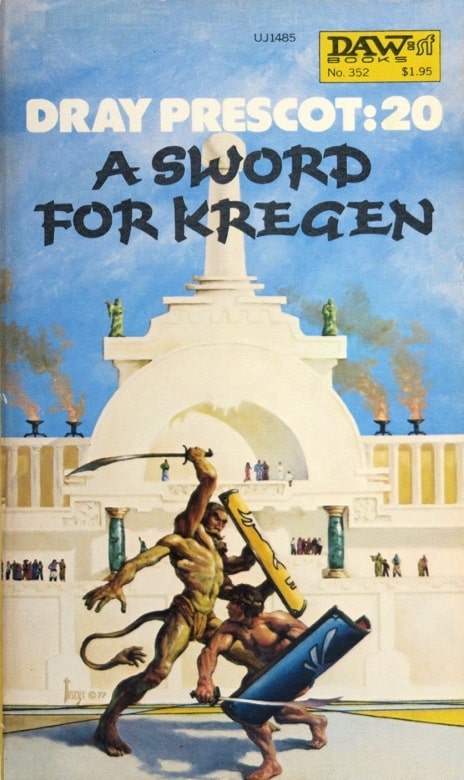 |
 |
Dray Prescot 20: A Sword for Kregen (DAW, August 1979) and Players of Gor
(DAW Books, March 1984). Covers by Richard Hescox and Ken Kelly
My second exposure to Sword & Planet chess came in one of my favorite Sword & Planet books, which I’ve mentioned in this series already a couple of times. This was A Sword for Kregen, by Alan Burt Akers (aka Ken Bulmer). In this book, Dray Prescot, our earthman hero, becomes a living Jikaida piece in a battle to the death.
Jikaida is war game similar to chess, although considerably more complicated. There are several different variations played across the world of Kregen. It’s usually played on a board of much more than 100 squares of either black and white or blue and yellow. There are typically 36 pieces to a side, arranged in three ranks. I never tried to play Jikaida, though the rules are available. Here’s a link to an online description of the game.
John Norman also introduced an S&P version of chess in his Gor series. He called it Kaissa, which is clearly a nod to the Goddess of chess — Caissa — who first appeared in a 1527 poem by Hieronymus Vida telling the story of a chess game between the Gods Apollo and Mercury.
Norman’s clearest description of the game came in book #20 of his series, called Players of Gor, although the complete rules aren’t included. Kaissa is played on a 100 square board alternating between red and yellow. Yellow moves first. There are two primary variants, either using 21 or 22 pieces to a side.
The game represents two warring cities trying to capture the other city’s “home stone,” which represents the soul of the city. Supposedly there’s a whole caste of “players” on Gor who dedicate their lives to Kaissa.
The Talera series by Charles Gramlich
Because Jetan, Jikaida and Kaissa captured my imagination so much, I had to introduce my own chess variant in the Talera series. There are two, simple and complex. They’re called Kyrel or Kyrellian. The playing board for Kyrel is a 100 squares of black and white. The two sides are called Crystal and Obsidian (or sometimes Jet). There are twenty pieces to a side.
In Kyrell, the simpler version, there are 2 players and each has a “homeland” consisting of twenty squares upon which his or her pieces start out. There is a bridge of 4 by 4 squares that connect the home field to the main board, called the war board. Pieces have to be moved across the bridge to begin the battle. On Talera, as on Earth, this game is often called the Game of Kings, and Kyr is a word meaning King in some Taleran languages.
In Kyrellian, the large version, the war board is 120 squares and there are 4 homelands so 4 players can play. In addition to Crystal and Obsidian, there are Argent and Vermillion. Each still has a 4 by 4 square bridge to move across to activate their players. Victory, in either version, comes when the opponent or opponents are captured or driven back fully onto their home board. In Kyrellian, alliances are possible and players can switch sides at any moment. Most Kyrellian games go on for many hours, usually with breaks, while Kyrell is more equivalent to a chess game in length.
Below are the pieces for Kyrel. However, although this game is mentioned several times in the Taleran series, I never produced a story revolving specifically around the game so I’ve never completely developed the rules. Not yet, anyway. So, you’re not going to find Kyrel and Kyrellian boards at your online stores for Christmas.
Crystal — Obsidian
Major pieces
Crystal prince, Obsidian Prince
Fire Rider, War Rider
Air Rider, Winged Rider
Earth Rider, Death Rider
Water Rider, Iron Rider
Minor pieces
The Owl, The Raven
Priest, Priest
The Wolf, The Beast
The Falconer, The Piper
The Sword, The Dagger
The Shield, The Stone
The Lance, The Thorn
The Angel, The Lady
Wind, Cloud
Mage, Sorceress
Lesser pieces
Slave, Slave
Trader/Merchant, Trader/Merchant
Singer, Singer
Child, Child
The Peasant, The Peasant
See Part One of Chess in Sword & Planet Fiction, discussing Edgar Rice Burroughs’s The Chessmen of Mars, here.
Charles Gramlich administers The Swords & Planet League group on Facebook, where this post first appeared. His last article for Black Gate was Part I of his look at Chess in Sword & Planet Fiction, The Chessmen of Mars.
